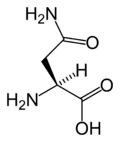Asparagine
| Asparagine | |
|---|---|
 |
 |
| IUPAC name | (2S)-2-amino-3-carbamoyl-propanoic acid |
| Identifiers | |
| CAS number | 70-47-3 |
| PubChem | |
| SMILES |
|
| Properties | |
| Molecular formula | C4H8N2O3 |
| Molar mass | 132.12 g mol−1 |
| Except where noted otherwise, data are given for materials in their standard state (at 25 °C, 100 kPa) Infobox references |
|
Asparagine (abbreviated as Asn or N; Asx or B represent either asparagine or aspartic acid) is one of the 20 most common natural amino acids on Earth. It has carboxamide as the side chain's functional group. It is not an essential amino acid. Its codons are AAU and AAC.[1]
A reaction between asparagine and reducing sugars or reactive carbonyls produces acrylamide (acrylic amide) in food when heated to sufficient temperature. These products occur in baked goods such as french fries, potato chips, and roasted coffee.
Contents |
History
Asparagine was first isolated in 1806 from asparagus juice, in which it is abundant -- hence its name -- becoming the first amino acid to be isolated. The characteristic smell observed in the urine of individuals after their consumption of asparagus is attributed to various metabolic byproducts of asparagine.
Structural function in proteins
Since the asparagine side chain can form hydrogen bond interactions with the peptide backbone, asparagine residues are often found near the beginning and the end of alpha-helices, and in turn motifs in beta sheets. Its role can be thought as "capping" the hydrogen bond interactions which would otherwise be satisfied by the polypeptide backbone. Glutamines, with an extra methylene group, have more conformational entropy and thus are less useful in this regard.
Asparagine also provides key sites for N-linked glycosylation, modification of the protein chain with the addition of carbohydrate chains.
Sources
Dietary Sources
Asparagine is not an essential amino acid, which means that it can be synthesized from central metabolic pathway intermediates in humans and is not required in the diet. Asparagine is found in:
- Animal sources: dairy, whey, beef, poultry, eggs, fish, lactalbumin, seafood
- Vegetarian sources: asparagus, potatoes, legumes, nuts, seeds, soy, whole grains
Biosynthesis
The precursor to asparagine is oxaloacetate. Oxaloacetate is converted to aspartate using a transaminase enzyme. The enzyme transfers the amino group from glutamate to oxaloacetate producing α-ketoglutarate and aspartate. The enzyme asparagine synthetase produces asparagine, AMP, glutamate, and pyrophosphate from aspartate, glutamine, and ATP. In the asparagine synthetase reaction, ATP is used to activate aspartate, forming β-aspartyl-AMP. Glutamine donates an ammonium group which reacts with β-aspartyl-AMP to form asparagine and free AMP.

Degradation
Aspartate is a glucogenic amino acid. L-asparginase hydrolyzes the amide group to form aspartate and ammonium. A transaminase converts the aspartate to oxaloacetate which can then be metabolized in the citric acid cycle or gluconeogenesis.
Function
The nervous system requires asparagine. It also plays an important role in the synthesis of ammonia.
References
- ↑ IUPAC-IUBMB Joint Commission on Biochemical Nomenclature. "Nomenclature and Symbolism for Amino Acids and Peptides". Recommendations on Organic & Biochemical Nomenclature, Symbols & Terminology etc. Retrieved on 2007-05-17.
External links
|
||||||||||||||